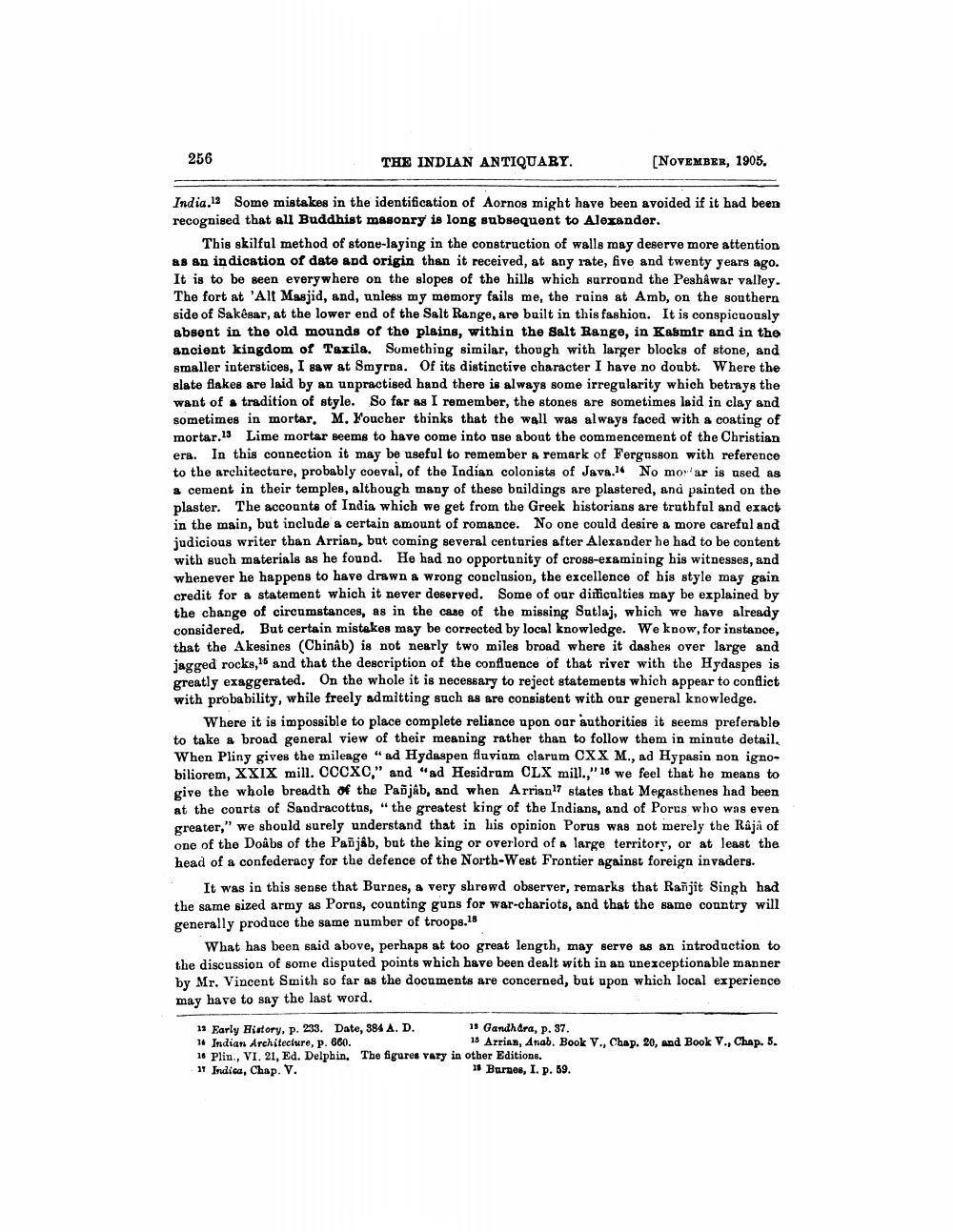________________
256
THE INDIAN ANTIQUARY.
[NOVEMBER, 1905,
India.12 Some mistakes in the identification of Aornos might have been avoided if it had been recognised that all Buddhist masonry is long subsequent to Alexander.
This skilful method of stone-laying in the construction of walls may deserve more attention as an indication of date and origin than it received, at any rate, five and twenty years ago. It is to be seen everywhere on the slopes of the hills which surround the Peshawar valley. The fort at 'All Masjid, and, unless my memory fails me, the ruins at Amb, on the southern side of Sakésar, at the lower end of the Salt Range, are built in this fashion. It is conspicuously absent in the old mounds of the plains, within the Salt Range, in Kasmir and in the ancient kingdom of Taxila. Something similar, though with larger blocks of stone, and smaller interstices, I saw at Smyrna. Of its distinctive character I have no doubt. Where the slate flakes are laid by an unpractised hand there is always some irregularity which betrays the want of a tradition of style. So far as I remember, the stones are sometimes laid in clay and sometimes in mortar, M. Foucher thinks that the wall was always faced with a coating of mortar. 13 Lime mortar seems to have come into use about the commencement of the Christian era. In this connection it may be useful to remember a remark of Fergusson with reference to the architecture, probably coeval, of the Indian colonists of Java. No mortar is used as a cement in their temples, although many of these buildings are plastered, and painted on the plaster. The accounts of India which we get from the Greek historians are truthful and exact in the main, but include a certain amount of romance. No one could desire a more careful and judicious writer than Arrian, but coming several centuries after Alexander he had to be content with such materials as he found. He had no opportunity of cross-examining his witnesses, and whenever he happens to have drawn a wrong conclusion, the excellence of his style may gain credit for a statement which it never deserved. Some of our difficulties may be explained by the change of circumstances, as in the case of the missing Sutlaj, which we have already considered. But certain mistakes may be corrected by local knowledge. We know, for instance, that the Akesines (Chinâb) is not nearly two miles broad where it dashes over large and jagged rocks, 15 and that the description of the confluence of that river with the Hydaspes is greatly exaggerated. On the whole it is necessary to reject statements which appear to conflict with probability, while freely admitting such as are consistent with our general knowledge.
Where it is impossible to place complete reliance upon our authorities it seems preferable to take a broad general view of their meaning rather than to follow them in minute detail. When Pliny gives the mileage "ad Hydaspen fluvium clarum CXX M., ad Hypasin non ignobiliorem, XXIX mill. CCCXC," and "ad Hesidrum CLX mill.," 16 we feel that he means to give the whole breadth of the Pañjab, and when Arrian17 states that Megasthenes had been at the courts of Sandracottus, "the greatest king of the Indians, and of Porus who was even greater," we should surely understand that in his opinion Porus was not merely the Raja of one of the Doâbs of the Panjab, but the king or overlord of a large territory, or at least the head of a confederacy for the defence of the North-West Frontier against foreign invaders.
It was in this sense that Burnes, a very shrewd observer, remarks that Ranjit Singh had the same sized army as Porns, counting guns for war-chariots, and that the same country will generally produce the same number of troops.18
What has been said above, perhaps at too great length, may serve as an introduction to the discussion of some disputed points which have been dealt with in an unexceptionable manner by Mr. Vincent Smith so far as the documents are concerned, but upon which local experience may have to say the last word.
12 Early History, p. 233. Date, 384 A. D.
14 Indian Architecture, p. 660.
16 Plin., VI. 21, Ed. Delphin. The figures vary in other Editions. 17 Indica, Chap. V.
Is Burnes, I.
15 Gandhara, p. 37.
15 Arrian, Anab. Book V., Chap. 20, and Book V., Chap. 5.
P. 59.




